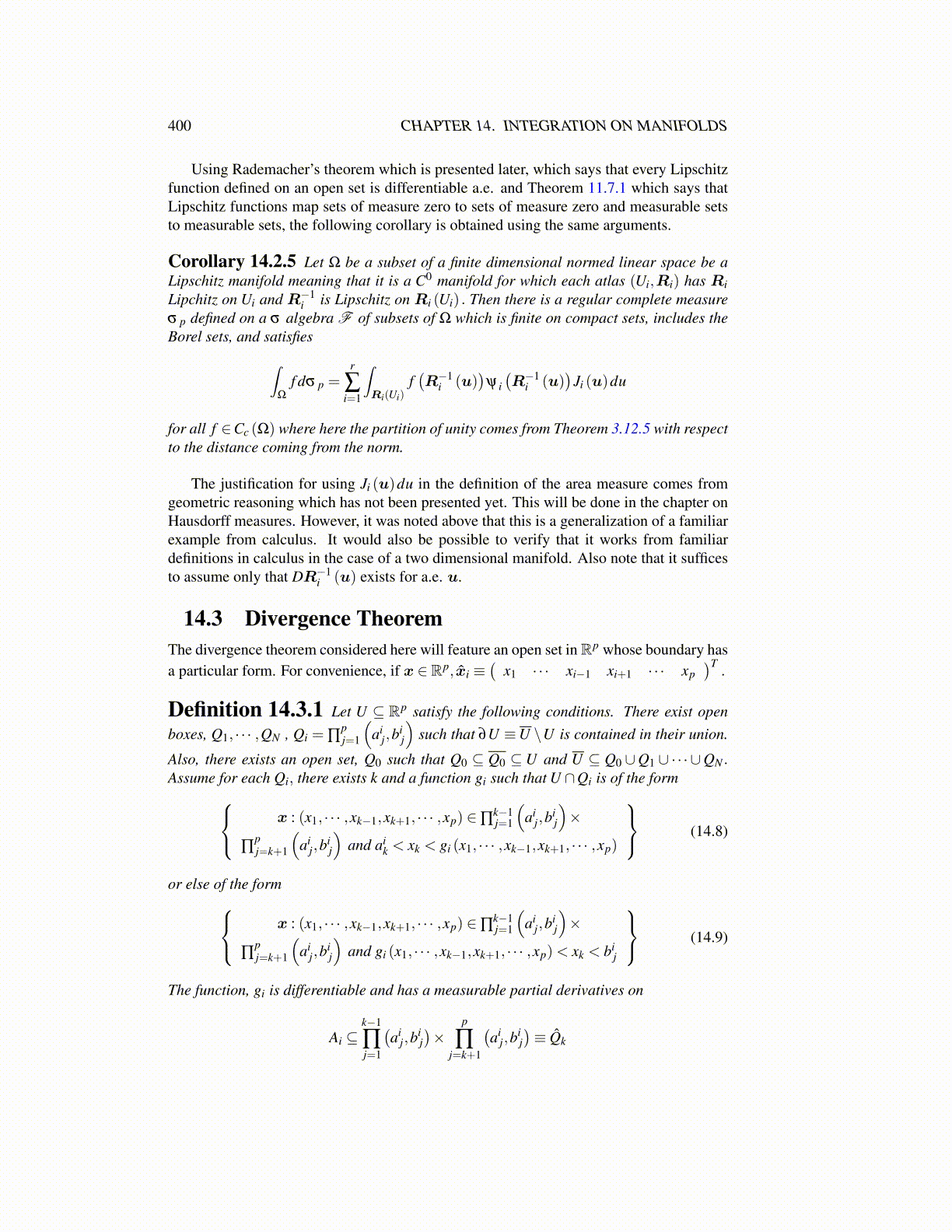
400 CHAPTER 14. INTEGRATION ON MANIFOLDS
Using Rademacher’s theorem which is presented later, which says that every Lipschitzfunction defined on an open set is differentiable a.e. and Theorem 11.7.1 which says thatLipschitz functions map sets of measure zero to sets of measure zero and measurable setsto measurable sets, the following corollary is obtained using the same arguments.
Corollary 14.2.5 Let Ω be a subset of a finite dimensional normed linear space be aLipschitz manifold meaning that it is a C0 manifold for which each atlas (Ui,Ri) has RiLipchitz on Ui and R−1
i is Lipschitz on Ri (Ui) . Then there is a regular complete measureσ p defined on a σ algebra F of subsets of Ω which is finite on compact sets, includes theBorel sets, and satisfies∫
Ω
f dσ p =r
∑i=1
∫Ri(Ui)
f(R−1
i (u))
ψ i(R−1
i (u))
Ji (u)du
for all f ∈Cc (Ω) where here the partition of unity comes from Theorem 3.12.5 with respectto the distance coming from the norm.
The justification for using Ji (u)du in the definition of the area measure comes fromgeometric reasoning which has not been presented yet. This will be done in the chapter onHausdorff measures. However, it was noted above that this is a generalization of a familiarexample from calculus. It would also be possible to verify that it works from familiardefinitions in calculus in the case of a two dimensional manifold. Also note that it sufficesto assume only that DR−1
i (u) exists for a.e. u.
14.3 Divergence TheoremThe divergence theorem considered here will feature an open set inRp whose boundary hasa particular form. For convenience, if x ∈ Rp, x̂i ≡
(x1 · · · xi−1 xi+1 · · · xp
)T.
Definition 14.3.1 Let U ⊆ Rp satisfy the following conditions. There exist openboxes, Q1, · · · ,QN , Qi = ∏
pj=1
(ai
j,bij
)such that ∂U ≡U \U is contained in their union.
Also, there exists an open set, Q0 such that Q0 ⊆ Q0 ⊆ U and U ⊆ Q0 ∪Q1 ∪ ·· · ∪QN .Assume for each Qi, there exists k and a function gi such that U ∩Qi is of the form x : (x1, · · · ,xk−1,xk+1, · · · ,xp) ∈∏
k−1j=1
(ai
j,bij
)×
∏pj=k+1
(ai
j,bij
)and ai
k < xk < gi (x1, · · · ,xk−1,xk+1, · · · ,xp)
(14.8)
or else of the form x : (x1, · · · ,xk−1,xk+1, · · · ,xp) ∈∏k−1j=1
(ai
j,bij
)×
∏pj=k+1
(ai
j,bij
)and gi (x1, · · · ,xk−1,xk+1, · · · ,xp)< xk < bi
j
(14.9)
The function, gi is differentiable and has a measurable partial derivatives on
Ai ⊆k−1
∏j=1
(ai
j,bij)×
p
∏j=k+1
(ai
j,bij)≡ Q̂k